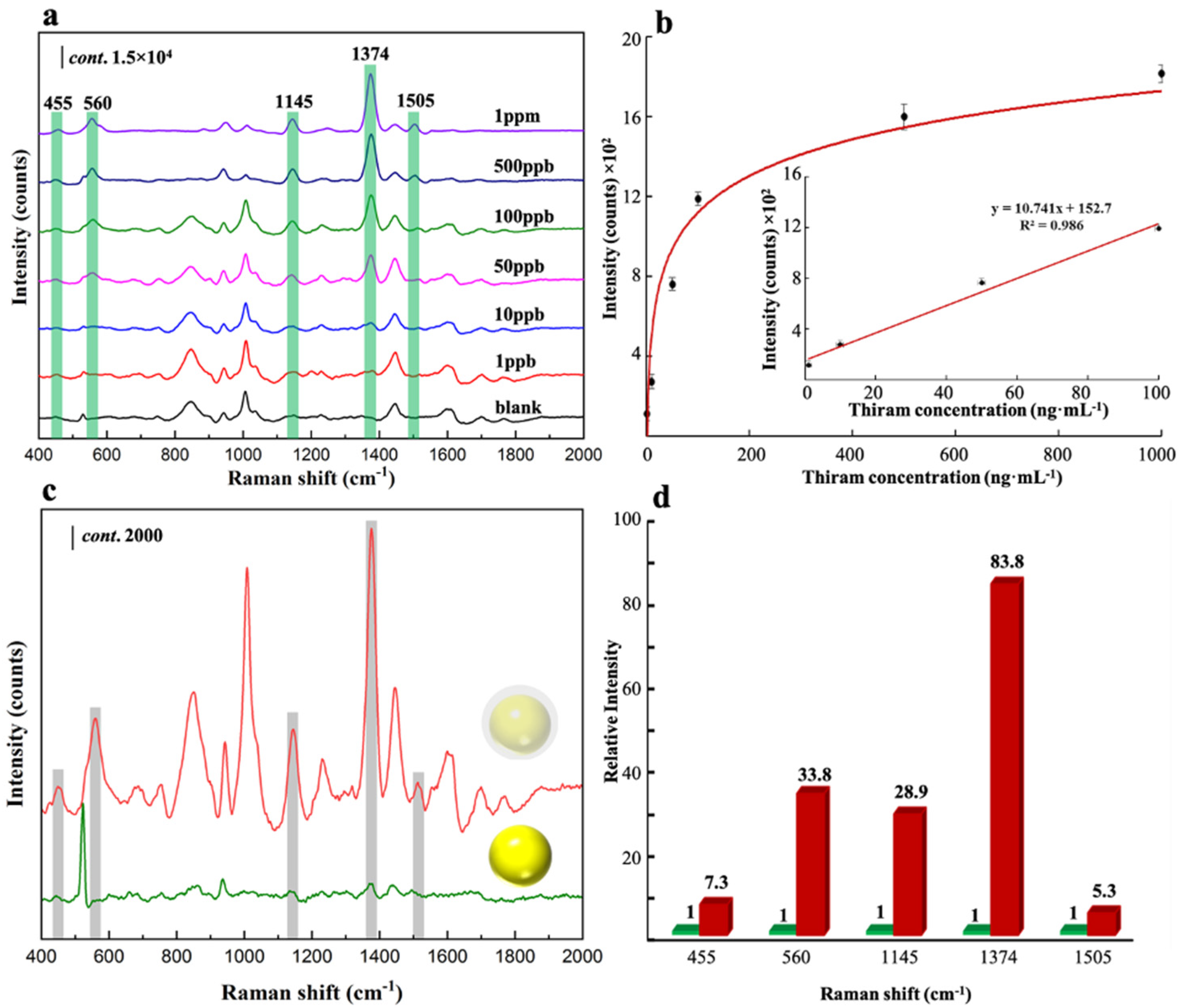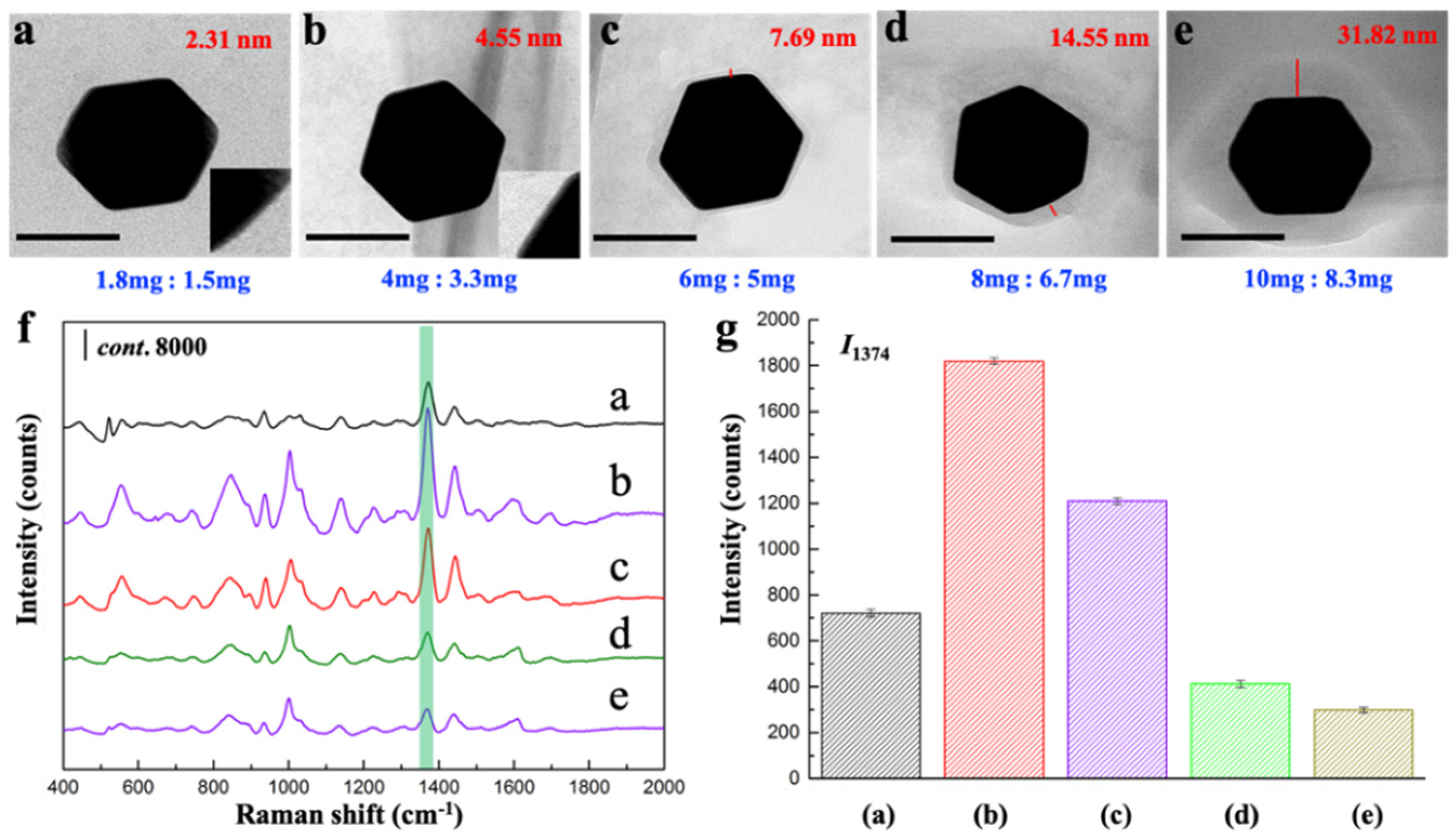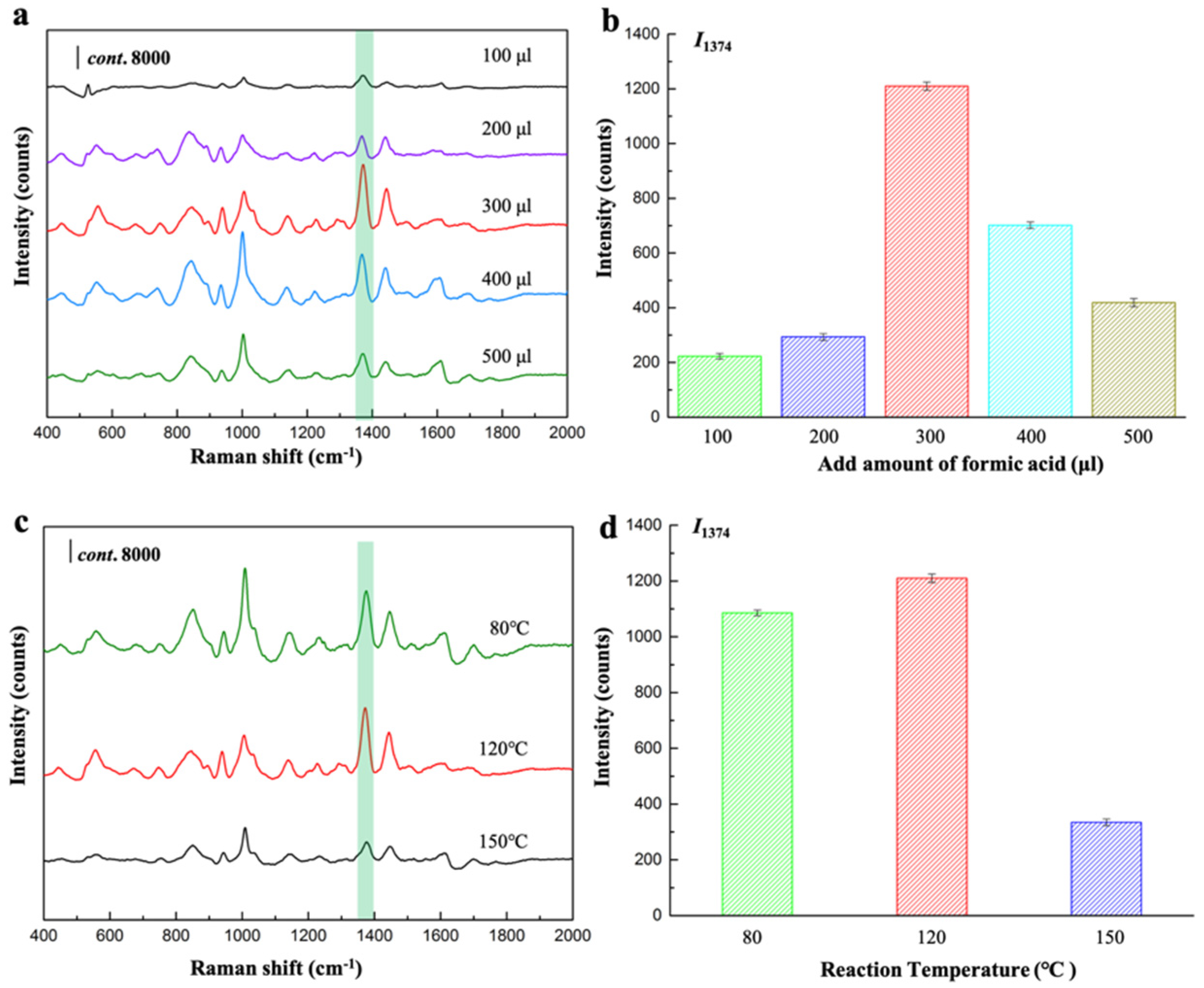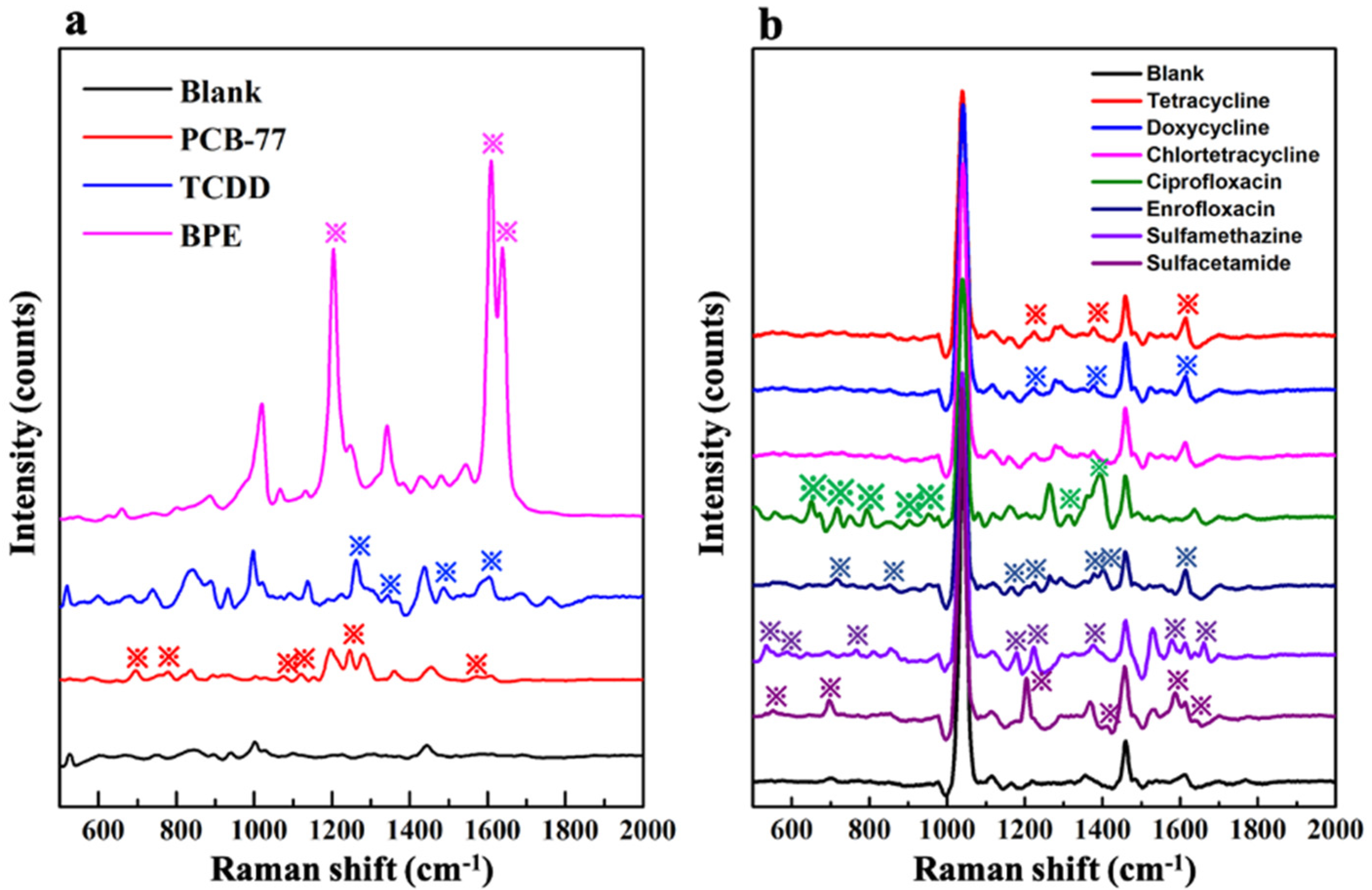Facile Regulation of Shell Thickness of the Au@MOF Core-Shell Composites for Highly Sensitive Surface-Enhanced Raman Scattering Sensing
Abstract
:1. Introduction
2. Materials and Methods
2.1. Reagents and Materials
2.2. One-Pot Synthesis of Core-Shell Au@BUT-17 NPs
2.3. Regulation of the Thickness of MOF Shell in Au@BUT-17 NPs
2.4. Characterization
2.5. SERS Measurement and Data Analysis
3. Results and Discussion
3.1. Synthesis and Characterizations
3.2. Regulation of the Thickness of Shell in Core-Shell Composites
3.3. Evaluate the Feasibility of the Developed Regulation Strategy
4. Conclusions
Supplementary Materials
Author Contributions
Funding
Institutional Review Board Statement
Informed Consent Statement
Data Availability Statement
Conflicts of Interest
References
- Yang, Y.Y.; Li, Y.T.; Zhai, W.L.; Li, X.J.; Li, D.; Lin, H.L.; Han, S. Electrokinetic preseparation and molecularly imprinted trapping for highly selective SERS detection of charged phthalate plasticizers. Anal. Chem. 2021, 93, 946–955. [Google Scholar] [CrossRef] [PubMed]
- Li, J.F.; Huang, Y.F.; Ding, Y.; Yang, Z.L.; Li, S.B.; Zhou, X.S.; Fan, F.R.; Zhang, W.; Zhou, Z.Y.; Wu, D.Y.; et al. Shell-isolated nanoparticle-enhanced Raman spectroscopy. Nature 2010, 464, 392–395. [Google Scholar] [CrossRef] [PubMed]
- Park, S.; Yang, P.X.; Corredor, P.; Weaver, M.J. Transition metal-coated nanoparticle films: vibrational characterization with surface-enhanced Raman scattering. J. Am. Chem. Soc. 2002, 124, 2428–2429. [Google Scholar] [CrossRef] [PubMed]
- Lee, H.K.; Lee, Y.H.; Koh, C.S.L.; Phan-Quang, G.C.X.; Han, M.; Lay, C.L.; Sim, H.Y.F.; Kao, Y.C.Q.; Qi, A.; Ling, X.Y. Designing surface-enhanced Raman scattering (SERS) platforms be-yond hotspot engineering: Emerging opportunities in analyte manipulations and hybrid materials. Chem. Soc. Rev. 2019, 48, 731–756. [Google Scholar] [CrossRef] [PubMed]
- Yang, X.Q.; Liu, Y.; Lam, S.H.; Wang, J.; Wen, S.Z.; Yam, C.Y.; Shao, L.; Wang, J.F. Site-selective deposition of Metal-Organic Frameworks on gold nanobipyramids for Surface-Enhanced Raman Scattering. Nano Lett. 2021, 21, 8205–8212. [Google Scholar] [CrossRef] [PubMed]
- Huang, C.H.; Li, A.L.; Chen, X.Y.; Wang, T. Understanding the role of metal-organic frameworks in surface-enhanced Raman scattering application. Small 2020, 16, 2004802. [Google Scholar] [CrossRef] [PubMed]
- Qiao, X.Z.; Su, B.S.; Liu, C.; Song, Q.; Luo, D.; Mo, G.; Wang, T. Selective Surface enhanced Raman scattering for quantitative detection of lung cancer biomarkers in superparticle @ MOF structure. Adv. Mater. 2018, 30, 1702275. [Google Scholar] [CrossRef] [PubMed]
- Wang, B.; Wang, P.L.; Xie, L.H.; Lin, R.B.; Lv, J.; Li, J.R.; Chen, B.L. A stable zirconium based metal-organic framework for specific recognition of representative polychlorinated dibenzo-p-dioxin molecules. Nat. Commun. 2019, 10, 3861. [Google Scholar] [CrossRef] [PubMed]
- Pastoriza-Santos, I.; Liz-Marzán, L.M. N,N-Dimethylformamide as a reaction medium for metal nanoparticle synthesis. Adv. Funct. Mater. 2009, 19, 679–688. [Google Scholar] [CrossRef]
- He, L.C.; Liu, Y.; Liu, J.Z.; Xiong, Y.S.; Zheng, J.Z.; Liu, L.Y.; Tang, Z.Y. Core-shell noble-metal @ Metal-Organic-Framework nanoparticles with highly selective sensing property. Angew. Chem. Int. Ed. 2013, 52, 3741–3745. [Google Scholar] [CrossRef] [PubMed]
- Lu, G.; Li, S.Z.; Guo, Z.; Farha, O.K.; Hauser, B.G.; Qi, X.Y.; Wang, Y.; Wang, X.; Han, S.Y.; Liu, X.G.; et al. Imparting functionality to a metal-organic framework material by controlled nanoparticle encapsulation. Nat. Chem. 2012, 4, 310–316. [Google Scholar] [CrossRef] [PubMed]
- Li, Z.C.; Xia, L.; Li, G.K.; Hu, Y.L. Raman spectroscopic imaging of pH values in cancerous tissue by using polyaniline@gold nanoparticles. Microchim. Acta 2019, 186, 162. [Google Scholar] [CrossRef] [PubMed]
- Liu, B.H.; Han, G.M.; Zhang, Z.P.; Liu, R.Y.; Jiang, C.L.; Wang, S.H.; Han, M.Y. Shell thickness-dependent Raman enhancement for rapid identification and detection of pesticide residues at fruit peels. Anal. Chem. 2012, 84, 255–261. [Google Scholar] [CrossRef] [PubMed]
- Wang, T.; Wang, S.P.; Cheng, Z.H.; Wei, J.C.; Yang, L.L.; Zhong, Z.F.; Hu, H.; Wang, Y.T.; Zhou, B.P.; Li, P. Emerging core–shell nanostructures for surface-enhanced Raman scattering (SERS) detection of pesticide residues. Chem. Eng. J. 2021, 424, 130323. [Google Scholar] [CrossRef]
- Panneerselvam, R.; Liu, G.K.; Wang, Y.H.; Liu, J.Y.; Ding, S.Y.; Li, J.F.; Wu, D.Y.; Tian, Z.Q. Surface-enhanced Raman spectroscopy: Bottlenecks and future directions. Chem. Commun. 2018, 54, 10–25. [Google Scholar] [CrossRef]
- Zhang, Y.S.; Hu, Y.F.; Li, G.K.; Zhang, R.K. A composite prepared from gold nanoparticles and a metal organic framework (type MOF-74) for determination of 4-nitrothiophenol by surface-enhanced Raman spectroscopy. Microchim. Acta 2019, 186, 477. [Google Scholar] [CrossRef]







Publisher’s Note: MDPI stays neutral with regard to jurisdictional claims in published maps and institutional affiliations. |
© 2022 by the authors. Licensee MDPI, Basel, Switzerland. This article is an open access article distributed under the terms and conditions of the Creative Commons Attribution (CC BY) license (https://creativecommons.org/licenses/by/4.0/).
Share and Cite
Li, B.; Liu, Y.; Cheng, J. Facile Regulation of Shell Thickness of the Au@MOF Core-Shell Composites for Highly Sensitive Surface-Enhanced Raman Scattering Sensing. Sensors 2022, 22, 7039. https://doi.org/10.3390/s22187039
Li B, Liu Y, Cheng J. Facile Regulation of Shell Thickness of the Au@MOF Core-Shell Composites for Highly Sensitive Surface-Enhanced Raman Scattering Sensing. Sensors. 2022; 22(18):7039. https://doi.org/10.3390/s22187039
Chicago/Turabian StyleLi, Boen, Yaling Liu, and Jie Cheng. 2022. "Facile Regulation of Shell Thickness of the Au@MOF Core-Shell Composites for Highly Sensitive Surface-Enhanced Raman Scattering Sensing" Sensors 22, no. 18: 7039. https://doi.org/10.3390/s22187039





